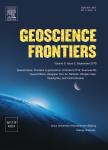Spectral characteristics of banded iron formations in Singhbhum craton,eastern India:Implications for hematite deposits on Mars
Spectral characteristics of banded iron formations in Singhbhum craton, eastern India: Implications for hematite deposits on Mars作者机构:Department of Earth and Space ScienceIndian Institute of Space Science and TechnologyValiamala P.O.Thiruvananthapuram 695 547India physical Research LaboratoryNavrangpuraAhmedabad 380009India Geological Survey of IndiaState Unit:OdishaNuipalliBhubaneswar 751012India
出 版 物:《Geoscience Frontiers》 (地学前缘(英文版))
年 卷 期:2016年第7卷第6期
页 面:927-936页
核心收录:
学科分类:081803[工学-地质工程] 08[工学] 0818[工学-地质资源与地质工程] 0708[理学-地球物理学] 0704[理学-天文学]
基 金:financially supported by Indian Institute of Space Science and Technology(IIST) Thiruvananthapuram
主 题:Banded iron formation Singhbhum craton VIS/NIR spectroscopy Raman spectroscopy Terrestrial analog Mars
摘 要:Banded iron formations (BIFs) are major rock units having hematite layers intermittent with silica rich layers and formed by sedimentary processes during late Archean to mid Proterozoic time. In terrestrial environment, hematite deposits are mainly found associated with banded iron formations. The BIFs in Lake Superior (Canada) and Carajas (Brazil) have been studied by planetary scientists to trace the evolution of hematite deposits on Mars. Hematite deposits are extensively identified in Meridiani region on Mars. Many hypotheses have been proposed to decipher the mechanism for the formation of these deposits. On the basis of geomorphological and mineralogical studies, aqueous environment of deposition is found to be the most supportive mechanism for its secondary iron rich deposits. In the present study, we examined the spectral characteristics of banded iron formations of Joda and Daitari located in Singhbhum craton in eastern India to check its potentiality as an analog to the aqueous/marine environment on Mars. The prominent banding feature of banded iron formations is in the range of few millimeters to few centimeters in thickness. Fe rich bands are darker (gray) in color compared to the light reddish jaspilitic chert bands. Thin quartz veins (〈4 mm) are occasionally observed in the handspecimens of banded iron formations. Spectral investigations have been conducted in VIS/NIR region of electromagnetic spectrum in the laboratory conditions. Optimum absorption bands identified include 0.65, 0.86, 1.4 and 1.9 μm, in which 0.56 and 0.86 μm absorption bands are due to ferric iron and 1.4 and 1,9 μm bands are due to OH/H2O. To validate the mineralogical results obtained from VlS/NIR spectral radiometry, laser Raman and Fourier transform infrared spectroscopic techniques were utilized and the results were found to be similar. Goethite-hematite association in banded iron formation in Singhbhum craton suggests dehydration activity, which has altered the primary iron oxide phases into the secondary iron oxide phases. The optimum bands identified for the minerals using various spectroscopic techniques can be used as reference for similar mineral deposits on any remote area on Earth or on other hydrated planetary surfaces like Mars.



